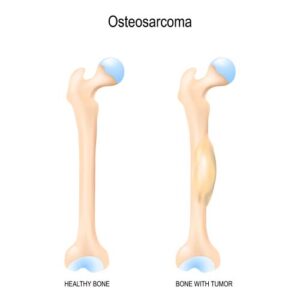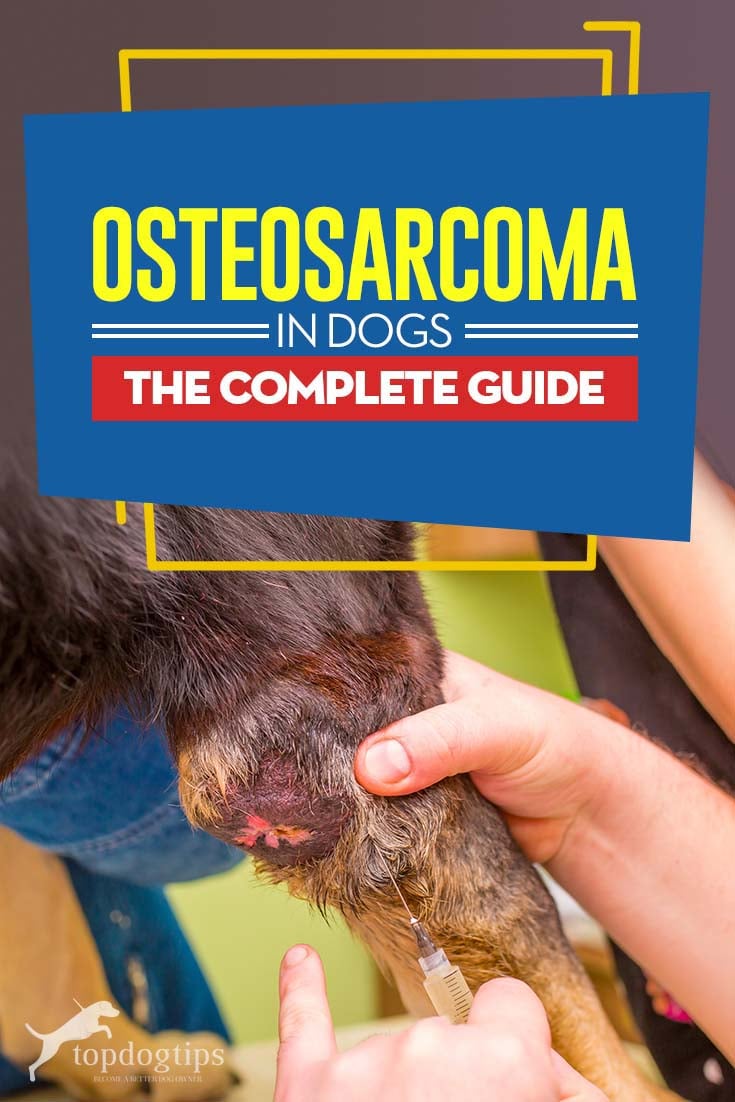Each year approximately 8,000 to 10,000 dogs are diagnosed with osteosarcoma. Most frequently seen in large and giant breed dogs, this aggressive bone cancer is known for rapid metastasis and, unfortunately, a poor overall prognosis. Here's everything you should know about osteosarcoma in dogs and what your options are for prevention, treatment and management.
What is Osteosarcoma?
A sarcoma is a type of cancerous tumor that begins growth in the bone, cartilage, fat, muscle, blood vessels, or other connective or supportive tissue. Since sarcomas can begin in various structures and the type of sarcoma is named after the area of growth, there are many different types of sarcoma tumors in dogs. Osteosarcoma is a sarcoma that specifically begins growth in the bone.
How Does Osteosarcoma in Dogs Grow?
 Healthy cells in the body perform a designated function and divide in a methodical way to facilitate growth or to replace damaged or depleted cells. Cancerous cells, however, don’t follow the same methodical pattern of function and division.
Healthy cells in the body perform a designated function and divide in a methodical way to facilitate growth or to replace damaged or depleted cells. Cancerous cells, however, don’t follow the same methodical pattern of function and division.
Cancerous cells grow and divide at a much faster rate without dying off which causes overpopulation of abnormal cells and prevents healthy cells from acting in a healthy way. As the number of abnormal cells increases rapidly, they can create a mass or “tumor” anywhere in the dog's body.
In the case of dog osteosarcoma, this abnormal cell growth takes place within the cells that are responsible for bone growth and bone reabsorption, or osteoblasts and osteoclasts. While the abnormal cells look similar to the cells that are usually found in the bone, they are not structurally sound and as they push out the normal cells in the area, they replace healthy tissue with weaker, cancerous tissue.
Osteosarcoma in dogs can grow inside of any of their bones, but it is most often seen in the wrist, knee, and shoulder of the front legs.
How Common is Dog Osteosarcoma?
According to the Animal Cancer Foundation, approximately 6 million dogs receive a new cancer diagnosis each year. Approximately 8,000 to 10,000 (or 1.3% to 1.6%) of those dogs are diagnosed with osteosarcoma.
Osteosarcoma can be found in a number of species including dogs, cats, and humans, but in all species, it seems to be a rather rare occurrence. That said, osteosarcoma is four times as common in dogs as it is in humans.
Large and giant breed dogs are those most often affected by osteosarcoma. It is estimated that almost 33% of canine osteosarcoma diagnoses are made in dogs over 90lbs, whereas dogs under 30 lbs account for less than 5% of diagnoses. The median age of diagnosis is around 8 years old yet a small peak of diagnoses are also made in dogs under 3 years old.

Factors That May Predispose a Dog to Osteosarcoma
Researchers have found a number of traits that seem to be prevalent in dogs that develop osteosarcoma, including heredity, breed, rate of growth, and gender.
Heredity
Heredity has been shown to play one of the largest roles in the development of dog osteosarcoma. A recent study on Scottish Deerhounds (chosen because of their low variability in genetic factors) by Phillips and colleagues published in Genomics (Phillips et al., 2007) found that almost 70% of cases of osteosarcoma were the result of heritable factors. Of course, this is just one breed and one study, but similar studies have also found a striking correlation between osteosarcoma in dogs and the heritable factor.
Breed
The breed of a dog, too, can influence their prevalence for an osteosarcoma diagnosis. While all breeds of dog can develop osteosarcoma, there are some breeds that seem to have a higher incidence of this type of cancer including the Saint Bernard, Great Dane, Irish Setter, Doberman Pinscher, Rottweiler, Scottish Deerhound, German Shepherd, and Golden Retriever.
Rate of Growth
Giant breeds are more commonly diagnosed with osteosarcoma, which isn’t surprising when a rapid rate of growth has also been named as another predisposing factor. Smaller breed dogs with a much slower rate of growth have been shown to have a significantly decreased prevalence of canine osteosarcoma.

Gender
Gender is another predisposing factor when it comes to diagnosing osteosarcoma in dogs. Studies have shown that males are between 20% and 50% more likely to develop osteosarcoma in comparison to female dogs.
ALSO READ: 7 Hidden Toxins in Your House That’re Cancerous to Dogs
Symptoms of Osteosarcoma in Dogs
Symptoms of osteosarcoma in dogs can be difficult to spot, but they mostly include:
- Swelling in the affected area
- Lameness that doesn’t subside
- A tumor or mass
- Lethargy
- Loss of appetite
- Signs of pain
Diagnosing Osteosarcoma in Dogs
Any of the symptoms above are not necessarily indicative of osteosarcoma but they do warrant a visit to your veterinarian for further testing. With as aggressive as osteosarcoma is, it is advisable to make an appointment with your vet as soon as you notice any symptoms that may indicate osteosarcoma (or any serious health concern for that matter).
During Your Vet Visit…
The first thing your vet will do during your appointment is a physical exam. This will give them a better feel for the overall state of your dog’s health as well as allow them to get a look at any presenting symptoms of osteosarcoma in your dog. This will also allow your vet to rule out any other possible causes for your pet's symptoms.
Once your vet has performed a physical, they will take a blood and urine sample for testing and order an x-ray.
If the x-ray shows any areas of concern, your vet will schedule a biopsy of the area and may order a CT scan. CT imaging is able to give your veterinarian a much clearer picture of any tumors in your dog’s limbs and is recommended because it also provides your dog’s surgeon with more information so that they can better determine whether your dog is a candidate for surgical removal.
A biopsy of the affected area will be performed by either putting your dog under anesthesia and taking a small fragment of bone or through a needle aspiration which only takes cells from the affected area rather than a piece of the bone.
All of this testing will help your vet to determine whether your dog has osteosarcoma, whether the osteosarcoma has metastasized, and what stage your dog’s osteosarcoma is.
The Stages of Osteosarcoma
Osteosarcoma is graded like many types of cancer in dogs using something called a “TNMG” system or “tumor, node, metastasis, grade” system. There are three stages to this system and two substages.
- Stage I refers to low-grade tumors that show no evidence of metastasis
- Stage II refers to high-grade tumors with no evidence of metastasis
- Stage III refers to dogs that have metastatic disease
In each of these stages, the substage “a” is used to refer to intramedullary lesions (lesions that are present in the medullary cavity of the bone). Substage “b” is used to refer to osteosarcoma in dogs that has spread outside of the medullary cavity of the bone but is confined locally.
Most diagnoses of osteosarcoma in dogs are made at stage II-b.
Treatment Options for Osteosarcoma in Dogs
While there are treatments available for osteosarcoma in dogs, these treatments are generally only able to treat symptoms and make your pet more comfortable. In most cases, canine osteosarcoma is not seen as a curable disease.
Surgical Intervention
The treatment of choice in dogs with osteosarcoma in the limbs is to have the tumor removed surgically. Surgical removal may or may not include amputation. Amputation is frequently the best option since to spare the limb and only remove the tumor requires the tumor to be in a specific location for complete removal.

Limb-sparing surgery also requires much more post-operative care and cost since it usually requires reconstruction of a segment of the bone which leaves the possibility for serious infection and failure of the reconstruction implant. Limb-sparing surgery also has a 15% to 20% rate of tumor recurrence.
Surgical intervention alone is usually not recommended, because it provides a shorter median survival time than dogs that receive combination treatments.
According to the science article on PubMed linked above, “What do we know about canine osteosarcoma treatment?” by M. Szewczyk, R. Lechowski, and K. Zabielska, information collected on osteosarcoma treatments in dogs between 1986 and 2003 show that dogs with metastasis of their osteosarcoma to local lymph nodes had an average survival time of 48 days after their diagnosis with surgery alone. Dogs without lymph node metastasis had an average survival time of 318 days.
Surgical Intervention and Chemotherapy
A second treatment approach to osteosarcoma in dogs is to combine the surgical method of tumor removal with chemotherapy. In one study cited by the article we referenced above, dogs with osteosarcoma that had their amputation followed by four cycles of chemotherapy (with carboplatin) had an average survival time of 307 days versus 138 days for those dogs that had amputation alone. Other chemotherapy drug studies have also been conducted with similar results.
Studies have also been conducted in which dogs received combination chemotherapy treatments following amputation and while results seem to be mixed, they still support the use of chemotherapy in prolonging life expectancy post-amputation in osteosarcoma.
Radiation Therapy
Radiation therapy is usually used for palliative care in dogs with osteosarcoma because it reduces pain relief and provides a longer survival time. Studies have shown that by combining surgical intervention with chemotherapy and radiation therapy seems to be the most effective method of treating dogs with osteosarcoma.
One study found that the average survival time in dogs receiving a combination of chemotherapy and radiation therapy following surgical intervention was 307 days. Unfortunately, since radiation therapy is expensive, is not always accessible, and requires a dog to be under anesthesia, it is not as widely utilized as it could be for managing osteosarcoma in dogs or other diseases.
The Importance of At-Home Care
In addition to whatever treatment approach you and your dog’s vet decide upon for your pooch, it’s important that you don’t forget about the importance of at-home care which can be very helpful for managing osteosarcoma in dogs. There are many things that you can do at home to make your pet more comfortable and to navigate the days ahead.
- Pain relief is crucial, so make sure to stay on top of your dog’s pain medications.
- If your dog has a short prognosis, keep a journal to monitor their quality of life, this will be helpful in determining when you should start considering euthanasia.
- Ensure that your dog has a supportive and comfortable (orthopedic) bed.
- Consider switching your dog to a “cancer diet” but not without talking to your vet first, and ensuring that you have a reputable resource for dietary information. We recommend consulting a holistic veterinarian (here's a sample recipe).
- Talk to your vet about supplements and additives to your dog’s food that can help your pet to live a more comfortable life. For example, bone broth or other types of dog food toppers can be a helpful additives to encourage eating if your dog is experiencing a loss of appetite due to cancer treatments.
- Keep your dog’s routine as normal as possible to avoid any unnecessary anxiety or stress for them.
It may be a difficult time when dealing with osteosarcoma in dogs, but there's help and support available for pet owners. You can find more great tips on at-home care for dogs with any types of cancer on CanineCancerAwareness.org.
READ NEXT: Bone Cancer in Dogs – What It Means for Your Dog and What to Do















